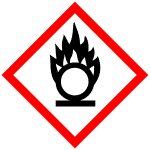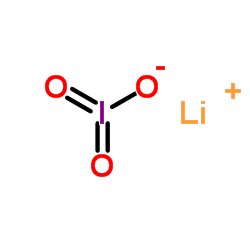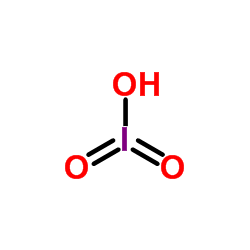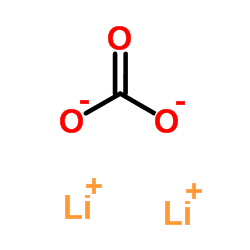13765-03-2
| 中文名 | 碘酸锂 |
|---|---|
| 英文名 | lithium,iodate |
| 英文别名 |
EINECS 237-365-2
MFCD00016189 lithium iodiate LithoTab iodate Lithium iodate Iodic acid (HIO3),lithium salt Iodic acid (HIO3),lithium salt (1:1) |
| 密度 | 4.50(17ºC) |
|---|---|
| 熔点 | 50-60ºC |
| 分子式 | ILiO3 |
| 分子量 | 181.844 |
| 精确质量 | 181.905212 |
| PSA | 57.20000 |
| LogP | 0.52930 |
| 储存条件 | 储存注意事项储存于阴凉、通风的库房。远离火种、热源。库温不超过30℃,相对湿度不超过80%。包装密封。应与易(可)燃物、还原剂等分开存放,切忌混储。储区应备有合适的材料收容泄漏物。 |
| 稳定性 | 1.碘酸锂有两种同质异构体,即α-LiIO3和β-LiIO3,这里介绍的是α-LiIO3。α-LiIO3属于非铁电性的极性晶体,具有旋光、热释电、压电、非线性光学、电光学效应。α-LiIO3晶体无色透明,是负光性单轴晶体。α-LiIO3晶体不是铁电体,不存在内电场,具有较强的抗光性。虽然是水溶性晶体,但不易潮解,能够承受较高的激光功率密度。α-LiIO3晶体具有较高的压电耦合、低的声表面波速度和低的延时温度系数及功率流角为零的特性,是制作长延迟线的极好材料。α-LiIO3具有良好的压电性能,是换能器的良好材料。 2.稳定性稳定 3.禁配物 还原剂、易燃或可燃物、活性金属粉末、硫、磷 4.避免接触的条件 受热 5.聚合危害 不聚合 6.分解产物 碘化物、氧化锂 |
| 分子结构 | 1、摩尔折射率:无可用的 2、摩尔体积(cm3/mol):无可用的 3、等张比容(90.2K):无可用的 4、表面张力(dyne/cm):无可用的 5、介电常数:无可用的 6、极化率(10-24cm3):无可用的 7、单一同位素质量:181.905208 Da 8、标称质量:182 Da 9、平均质量:181.8437 Da |
| 计算化学 | 1.疏水参数计算参考值(XlogP):无 2.氢键供体数量:0 3.氢键受体数量:3 4.可旋转化学键数量:0 5.互变异构体数量:无 6.拓扑分子极性表面积57.2 7.重原子数量:5 8.表面电荷:0 9.复杂度:49.8 10.同位素原子数量:0 11.确定原子立构中心数量:0 12.不确定原子立构中心数量:0 13.确定化学键立构中心数量:0 14.不确定化学键立构中心数量:0 15.共价键单元数量:2 |
| 更多 | 1.性状:无色有光泽的结晶,有潮解性。 2.熔点(ºC):420 3.相对密度(水=1):4.50(17ºC) 4.溶解性:溶于水,不溶于乙醇。 |
|
Section1. IDENTIFICATION OF THE SUBSTANCE/MIXTURE Product identifiers Product name: Lithium iodate CAS-No.: 13765-03-2 Relevant identified uses of the substance or mixture and uses advised against Identified uses: Laboratory chemicals, Manufacture of substances Section2. HAZARDS IDENTIFICATION Classification of the substance or mixture Classification according to Regulation (EC) No 1272/2008 [EU-GHS/CLP] Oxidizing solids (Category 2) Skin irritation (Category 2) Eye irritation (Category 2) Reproductive toxicity (Category 1B) Specific target organ toxicity - single exposure (Category 3) Classification according to EU Directives 67/548/EEC or 1999/45/EC May cause harm to the unborn child. Contact with combustible material may cause fire. Irritating to eyes, respiratory system and skin. Label elements Labelling according Regulation (EC) No 1272/2008 [CLP] Pictogram Signal wordDanger Hazard statement(s) H272May intensify fire; oxidiser. H315Causes skin irritation. H319Causes serious eye irritation. H335May cause respiratory irritation. H360May damage fertility or the unborn child. Precautionary statement(s) P201Obtain special instructions before use. P220Keep/Store away from clothing/ combustible materials. P261Avoid breathing dust/ fume/ gas/ mist/ vapours/ spray. P305 + P351 + P338IF IN EYES: Rinse cautiously with water for several minutes. Remove contact lenses, if present and easy to do. Continue rinsing. P308 + P313IF exposed or concerned: Get medical advice/ attention. Supplemental Hazardnone Statements According to European Directive 67/548/EEC as amended. Hazard symbol(s) R-phrase(s) R61May cause harm to the unborn child. R8Contact with combustible material may cause fire. R36/37/38Irritating to eyes, respiratory system and skin. S-phrase(s) S53Avoid exposure - obtain special instructions before use. S17Keep away from combustible material. S22Do not breathe dust. S36/37/39Wear suitable protective clothing, gloves and eye/face protection. S45In case of accident or if you feel unwell, seek medical advice immediately (show the label where possible). Restricted to professional users. Other hazards - none Section3. COMPOSITION/INFORMATION ON INGREDIENTS Substances Formula: ILiO3 Molecular Weight: 181,84 g/mol ComponentConcentration Lithiumiodat CAS-No.13765-03-2- EC-No.237-365-2 Section4. FIRST AID MEASURES Description of first aid measures General advice Consult a physician. Show this safety data sheet to the doctor in attendance. If inhaled If breathed in, move person into fresh air. If not breathing, give artificial respiration. Consult a physician. In case of skin contact Wash off with soap and plenty of water. Consult a physician. In case of eye contact Rinse thoroughly with plenty of water for at least 15 minutes and consult a physician. If swallowed Never give anything by mouth to an unconscious person. Rinse mouth with water. Consult a physician. Most important symptoms and effects, both acute and delayed Large doses of lithium ion have caused dizziness and prostration, and can cause kidney damage if sodium intake is limited. Dehydration, weight loss, dermatological effects, and thyroid disturbances have been reported. Central nervous system effects that include slurred speech, blurred vision, sensory loss, ataxia, and convulsions may occur. Diarrhea, vomiting, and neuromuscular effects such as tremor, clonus, and hyperactive reflexes may occur as a result of repeated exposure to lithium ion., Prolonged exposure to iodides may produce iodism in sensitive individuals. Symptoms of exposure include: skin rash, running nose, headache and irritation of the mucous membrane. For severe cases the skin may show pimples, boils, hives, blisters and black and blue spots. Iodides are readily diffused across the placenta. Neonatal deaths from respiratory distress secondary to goiter have been reported. Iodides have been known to cause drug-induced fevers, which are usually of short duration., To the best of our knowledge, the chemical, physical, and toxicological properties have not been thoroughly investigated. Indication of any immediate medical attention and special treatment needed no data available Section5. FIREFIGHTING MEASURES Extinguishing media Suitable extinguishing media Use water spray, alcohol-resistant foam, dry chemical or carbon dioxide. Special hazards arising from the substance or mixture Lithium oxides Advice for firefighters Wear self contained breathing apparatus for fire fighting if necessary. Further information Use water spray to cool unopened containers. Section6. ACCIDENTAL RELEASE MEASURES Personal precautions, protective equipment and emergency procedures Use personal protective equipment. Avoid dust formation. Avoid breathing vapors, mist or gas. Ensure adequate ventilation. Evacuate personnel to safe areas. Avoid breathing dust. Environmental precautions Prevent further leakage or spillage if safe to do so. Do not let product enter drains. Methods and materials for containment and cleaning up Sweep up and shovel. Contain spillage, and then collect with an electrically protected vacuum cleaner or by wet-brushing and place in container for disposal according to local regulations (see section 13). Keep in suitable, closed containers for disposal. Reference to other sections For disposal see section 13. Section7. HANDLING AND STORAGE Precautions for safe handling Avoid contact with skin and eyes. Avoid formation of dust and aerosols.Avoid exposure - obtain special instructions before use. Provide appropriate exhaust ventilation at places where dust is formed.Keep away from sources of ignition - No smoking.Keep away from heat and sources of ignition.Normal measures for preventive fire protection. Conditions for safe storage, including any incompatibilities Store in cool place. Keep container tightly closed in a dry and well-ventilated place. Specific end use(s) no data available Section8. EXPOSURE CONTROLS/PERSONAL PROTECTION Control parameters Components with workplace control parameters Exposure controls Appropriate engineering controls Handle in accordance with good industrial hygiene and safety practice. Wash hands before breaks and at the end of workday. Personal protective equipment Eye/face protection Safety glasses with side-shields conforming to EN166 Use equipment for eye protection tested and approved under appropriate government standards such as NIOSH (US) or EN 166(EU). Skin protection Handle with gloves. Gloves must be inspected prior to use. Use proper glove removal technique (without touching glove's outer surface) to avoid skin contact with this product. Dispose of contaminated gloves after use in accordance with applicable laws and good laboratory practices. Wash and dry hands. The selected protective gloves have to satisfy the specifications of EU Directive 89/686/EEC and the standard EN 374 derived from it. Body Protection Impervious clothing., The type of protective equipment must be selected according to the concentration and amount of the dangerous substance at the specific workplace. Respiratory protection Where risk assessment shows air-purifying respirators are appropriate use a full-face particle respirator type N100 (US) or type P3 (EN 143) respirator cartridges as a backup to engineering controls. If the respirator is the sole means of protection, use a full-face supplied air respirator. Use respirators and components tested and approved under appropriate government standards such as NIOSH (US) or CEN (EU). Section9. PHYSICAL AND CHEMICAL PROPERTIES Information on basic physical and chemical properties a) AppearanceForm: crystalline Colour: white b) Odourno data available c) Odour Thresholdno data available d) pHno data available e) Melting point/freezingno data available point f) Initial boiling point and no data available boiling range g) Flash pointnot applicable h) Evaporation rateno data available i) Flammability (solid, gas) no data available j) Upper/lowerno data available flammability or explosive limits k) Vapour pressureno data available l) Vapour densityno data available m) Relative densityno data available n) Water solubilityno data available o) Partition coefficient: n- no data available octanol/water p) Auto-ignitionno data available temperature q) Decompositionno data available temperature r) Viscosityno data available s) Explosive propertiesno data available t) Oxidizing propertiesThe substance or mixture is classified as oxidizing with the category 2. Other safety information no data available Section10. STABILITY AND REACTIVITY Reactivity no data available Chemical stability no data available Possibility of hazardous reactions no data available Conditions to avoid no data available Incompatible materials Strong acids, Strong reducing agents, Organic materials, Powdered metals Hazardous decomposition products Other decomposition products - no data available Section11. TOXICOLOGICAL INFORMATION Information on toxicological effects Acute toxicity no data available Inhalation: no data available Skin corrosion/irritation no data available Serious eye damage/eye irritation no data available Respiratory or skin sensitization Prolonged or repeated exposure may cause allergic reactions in certain sensitive individuals. Germ cell mutagenicity no data available Carcinogenicity IARC:No component of this product present at levels greater than or equal to 0.1% is identified as probable, possible or confirmed human carcinogen by IARC. Reproductive toxicity Presumed human reproductive toxicant Specific target organ toxicity - single exposure Inhalation - May cause respiratory irritation. Specific target organ toxicity - repeated exposure no data available Aspiration hazard no data available Potential health effects InhalationMay be harmful if inhaled. Causes respiratory tract irritation. IngestionMay be harmful if swallowed. SkinMay be harmful if absorbed through skin. Causes skin irritation. Eyes Causes serious eye irritation. Signs and Symptoms of Exposure Large doses of lithium ion have caused dizziness and prostration, and can cause kidney damage if sodium intake is limited. Dehydration, weight loss, dermatological effects, and thyroid disturbances have been reported. Central nervous system effects that include slurred speech, blurred vision, sensory loss, ataxia, and convulsions may occur. Diarrhea, vomiting, and neuromuscular effects such as tremor, clonus, and hyperactive reflexes may occur as a result of repeated exposure to lithium ion., Prolonged exposure to iodides may produce iodism in sensitive individuals. Symptoms of exposure include: skin rash, running nose, headache and irritation of the mucous membrane. For severe cases the skin may show pimples, boils, hives, blisters and black and blue spots. Iodides are readily diffused across the placenta. Neonatal deaths from respiratory distress secondary to goiter have been reported. Iodides have been known to cause drug-induced fevers, which are usually of short duration., To the best of our knowledge, the chemical, physical, and toxicological properties have not been thoroughly investigated. Additional Information RTECS: Not available Section12. ECOLOGICAL INFORMATION Toxicity no data available Persistence and degradability no data available Bioaccumulative potential no data available Mobility in soil no data available Results of PBT and vPvB assessment no data available Other adverse effects no data available Section13. DISPOSAL CONSIDERATIONS Waste treatment methods Product Burn in a chemical incinerator equipped with an afterburner and scrubber but exert extra care in igniting as this material is highly flammable. Offer surplus and non-recyclable solutions to a licensed disposal company. Contact a licensed professional waste disposal service to dispose of this material. Contaminated packaging Dispose of as unused product. Section14. TRANSPORT INFORMATION UN number ADR/RID: 1479IMDG: 1479IATA: 1479 UN proper shipping name ADR/RID: OXIDIZING SOLID, N.O.S. (Lithiumiodat) IMDG:OXIDIZING SOLID, N.O.S. (Lithiumiodat) IATA:Oxidizing solid, n.o.s. (Lithiumiodat) Transport hazard class(es) ADR/RID: 5.1IMDG: 5.1IATA: 5.1 Packaging group ADR/RID: IIIMDG: IIIATA: II Environmental hazards ADR/RID: yesIMDG Marine Pollutant: yesIATA: no Special precautions for user no data available Section15. REGULATORY INFORMATION This safety datasheet complies with the requirements of Regulation (EC) No. 1907/2006. Safety, health and environmental regulations/legislation specific for the substance or mixture no data available Chemical Safety Assessment no data available Section16. OTHER INFORMATION Further information Copyright 2012 Co. LLC. License granted to make unlimited paper copies for internal use only. The above information is believed to be correct but does not purport to be all inclusive and shall be used only as a guide. The information in this document is based on the present state of our knowledge and is applicable to the product with regard to appropriate safety precautions. It does not represent any guarantee of the properties of the product. Corporation and its Affiliates shall not be held liable for any damage resulting from handling or from contact with the above product. See and/or the reverse side of invoice or packing slip for additional terms and conditions of sale. |
|
毒理学数据: 1.急性毒性 暂无资料 2.刺激性 暂无资料 3.致畸性 可能引起出生缺陷,孕妇不宜使用。频繁使用碘化物可致胎儿死亡,严重的甲状腺肿和甲状腺机能衰退,新生儿呈现克汀病样体征。 生态学数据: 1.生态毒性 暂无资料 2.生物降解性 暂无资料 3.非生物降解性 暂无资料
|
| 符号 |



GHS03, GHS07, GHS08 |
|---|---|
| 信号词 | Danger |
| 危害声明 | H272-H315-H319-H335-H360 |
| 警示性声明 | P201-P220-P261-P305 + P351 + P338-P308 + P313 |
| 个人防护装备 | Eyeshields;full-face particle respirator type N100 (US);Gloves;respirator cartridge type N100 (US);type P1 (EN143) respirator filter;type P2 (EN 143) respirator cartridges;type P3 (EN 143) respirator cartridges |
| 危害码 (欧洲) | O: Oxidizing agent;T: Toxic; |
| 风险声明 (欧洲) | R61 |
| 安全声明 (欧洲) | S53-S17-S22-S36/37/39-S45 |
| 危险品运输编码 | UN 1479 5.1/PG 2 |
| WGK德国 | 3 |
| 包装等级 | II |
| 危险类别 | 5.1 |
|
~% 
13765-03-2 |
| 文献:Annalen der Physik (Weinheim, Germany), , vol. 44, p. 555 Annalen der Physik (Weinheim, Germany), , vol. 66, p. 83 - 83 Ann. Chim. Phys., , vol. 51, p. 137 - 137 |
|
~% 
13765-03-2 |
| 文献:Acta Chimica Academiae Scientiarum Hungaricae, , vol. 110, # 2 p. 175 - 182 |


